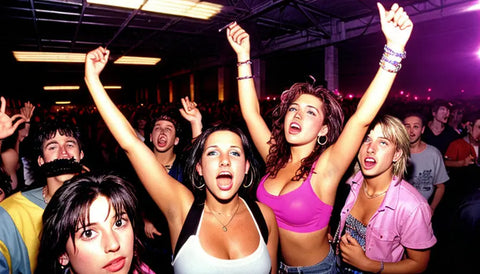Rhythms of Rebellion: Tracing the Beat from 1980s Underground to Today's Global Rave Phenomenon - History of Raving!
Posted by BRIAN R

The History of Raving
It's a vibrant tapestry that reflects the evolution of youth culture, music, and communal celebration. The rave phenomenon, as we recognize it today, originated in England during the late 1980s. These gatherings were initially known as acid house parties, characterized by their clandestine settings such as warehouses, aircraft hangars, and barns, fostering an atmosphere of freedom and escape from societal norms. The etymology of "rave" is thought to hark back to a Scandinavian word that conveys the idea of wandering or roaming, which aptly captures the spirit of these early events.

Rave culture sprouted from a youth movement that gravitated towards atypical music marked by heavy beats and bass produced electronically, diverging from traditional instruments like guitars. This shift in musical preference was a significant marker of the rave identity. The scene created a unique and almost magical environment, where like-minded individuals came together to dance, often in an enhanced state of consciousness, to various forms of electronic music, allowing them to lose themselves in the music for extended periods.
The early 1980s marked the inception of rave culture, coinciding with the height of electronic music as a mainstream genre. It was during this era that European techno and American house music captivated the hearts of middle-class youths. These young people would congregate at secret acid house parties held in unconventional and often unimaginable locations, pushing the boundaries of the traditional party scene.
The British rave scene, particularly from the late 1980s to the early 1990s, is remembered as a time of pure joy and community. A particularly notable period was the Second Summer of Love in 1989, when thousands of young people came together at illegal parties. The hypnotic beats of house music and the widespread use of the drug ecstasy during these events are seen through a lens of nostalgia today.
The emergence of rave culture was not just a musical revolution but also a social and cultural one. It offered a space for expression, belonging, and celebration away from the constraints of everyday life, leaving an indelible mark on the cultural landscape that continues to be celebrated and revisited through various forms of media and music festivals around the world.
Modern Raving Today - What is the EDM Culture like?
Raving has evolved significantly from its underground roots in the 1980s to the global phenomenon it is today. The term "EDM" or Electronic Dance Music, which surfaced around 2010, encompasses a wide array of dance music subgenres that evolved from house music, including trance, big room, future house, dubstep, and progressive house. Today, raving is often associated with massive international festivals like Tomorrowland, which attract hundreds of thousands of fans and feature world-famous DJ headliners, representing a significant shift from the small, illicit gatherings of the past.

Despite debates about whether the commercialized nature of these events still aligns with the traditional concept of a "rave," there remains a vibrant scene for house and dance music, where attendees share a collective enjoyment of the music and, at times, the psychoactive experiences of their predecessors. Events such as Kappa FuturFestival in Italy pay homage to the traditional rave culture while operating within a legal and commercial framework.
EDM has now become a global genre, with top DJs achieving international superstardom and earning substantial incomes from festivals and residencies at major nightclubs around the world. This global spread has been exemplified by festivals like Ultra Music Festival, which now takes place in multiple countries across the globe.
The modern EDM event is a high-end, audio-visual spectacle featuring elaborate light shows, lasers, projections, fireworks, and live performers, all designed to create an immersive and exhilarating experience for attendees. This demonstrates how far EDM has come from its humble beginnings, transitioning into a profitable component of the international nightlife industry.
In essence, while the rave scene has diversified and commercialized, the core elements of community, music, and celebration remain integral, illustrating the enduring appeal and adaptability of rave culture.
SHARE:


